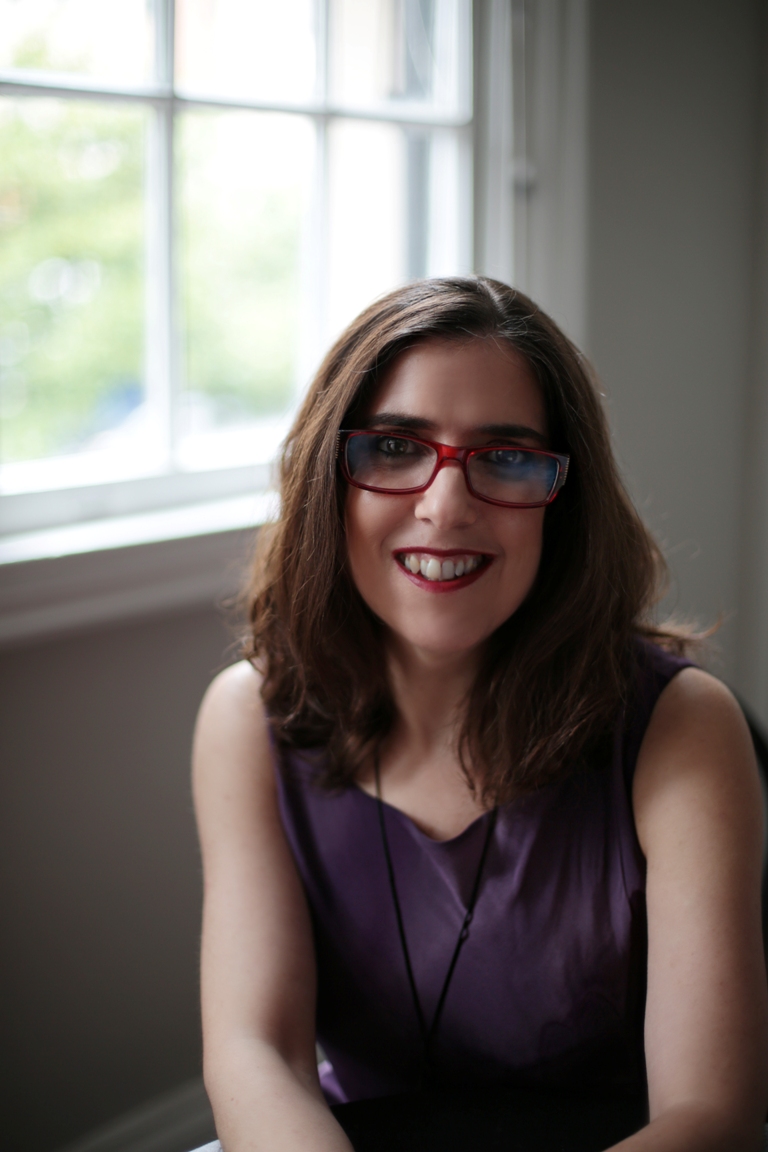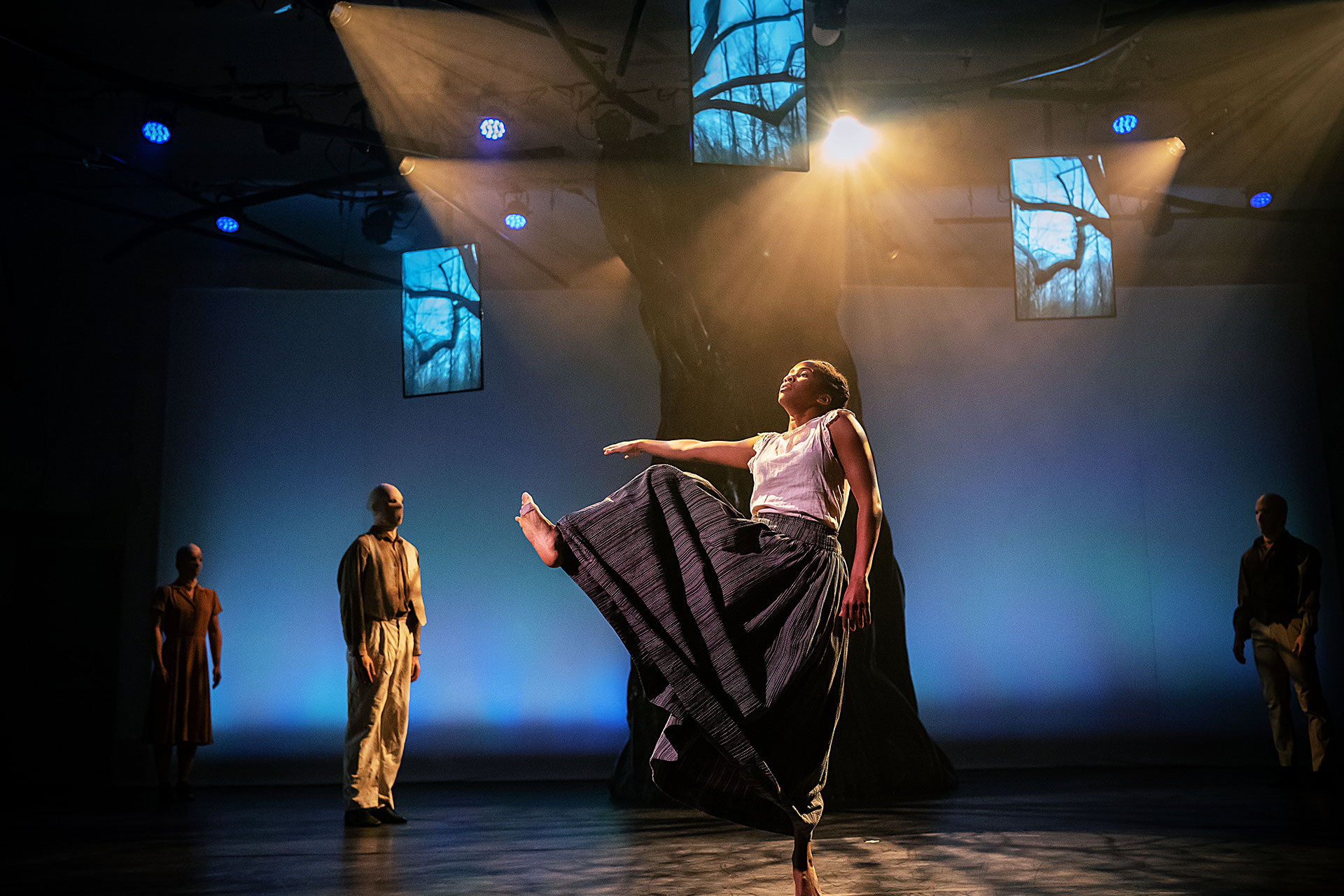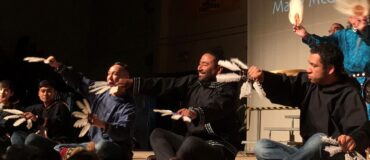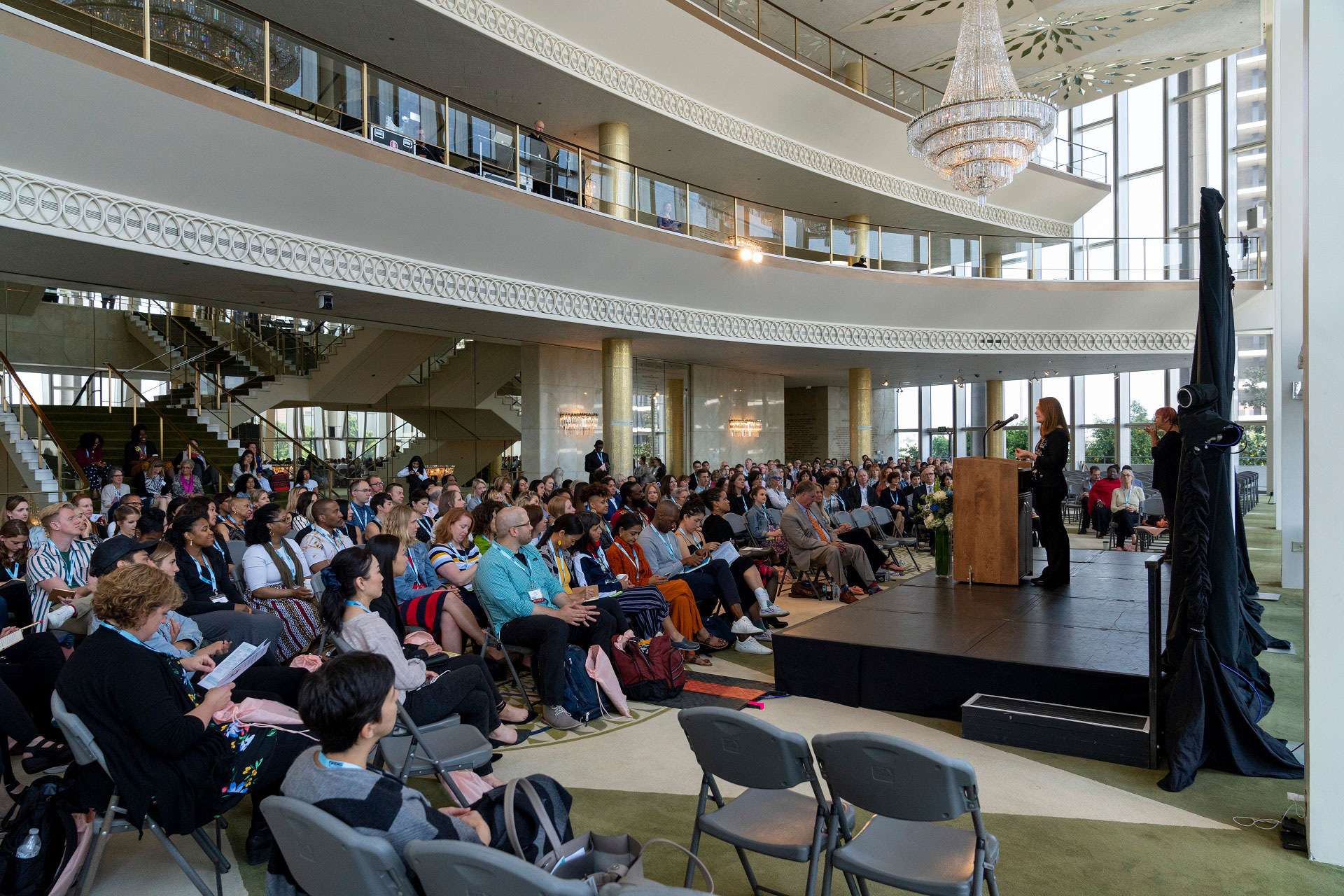Feeling a Sense of Belonging in the Dance Arena
By Lisa Traiger

Grace Gillette, photo: Keya Clairmont
Grace “SwaHuux” Gillette has been overseeing the Denver March Powwow for more than four decades. Raised on the Fort Berthold Reservation in North Dakota, Gillette and her siblings didn’t learn the traditional dances and language of their Arikara forebears. Both her parents were of the generation of Native Americans who were deprived of their culture and language, forced to speak only English at school and sent to live in boarding schools, separated from their families. Gillette broke that cycle to share Native American dance and music with tens of thousands in a massive three-day program in downtown Denver. The Denver March Powwow began as a modest gathering in the ballroom of the Indian Culture Center in Denver. In recent years the event has drawn more than 55,000 spectators to the Denver Coliseum each spring. The registered dance groups represent about 95 different tribes from 35 states and five Canadian provinces. Gillette noted that 1,500 dancers participate joined by 35 drum groups. Alas, the 2020 and 2021 powwows had to be cancelled due to the ongoing pandemic. This year would have been the 47th. The Dance/USA Board of Trustees recognizes Miss Grace as an outstanding professional in the dance field. Her work has impacted countless Native American dancers, musicians and participants through the powwow, as well as the greater Denver community and surrounding environs. Grace Gillette receives the Trustees Award March 10, 2021. You may read more about Gillette here.
Dance/USA: Please introduce us to powwow culture.
Grace Gillette: The term powwow is contemporary. Years ago there were social dances and it began with just the men dancing. When the men came from a hunt or from battle, they would reenact what they had done. Then as time progressed, these reenactments became social events where the women would dance, just on the outer edges, while the men danced in the circle. As time went on, the dances became part of wedding ceremonies, naming ceremonies, or any life event where a celebration was involved. Then it became social dancing, which grew as travel became easier with cars and interstate highways. Tribes could visit other reservations where they would see social dancing and intertribal dancing. By the late 1950s and early 1960s, competition dancing started.

Chief Phillip Whiteman, Jr., accompanies Gillette at the Grand Entry of the 2017 Denver March Powwow, photo: Brian Fraker
We always had social dance powwows in the Northern Plain States, while they’re newer for the Southwest, the California, the Western tribes and Southeastern tribes. As powwows became more popular and communication grew throughout America, interest grew because many other tribes only had their ceremonial dances, which were not open to the general public. So the intertribal powwow dances became very popular social events.
D/USA: Would you speak about your dance background because I understand that you did not learn traditional Arikara dances and language as a child. When did that happen?
G.G.: That’s correct. Our parents were of the generation that was forced to go to boarding school. They weren’t allowed to speak their language. It was a hard time for them: growing up at home they spoke English. We didn’t learn the language, so whenever friends came to visit, or we went to visit a family and our tribe, my parents would sit there but could visit in the traditional language.
In the powwow culture, you don’t just go out to the arena and dance. There are ceremonies. You need to have your naming ceremony and be given the right to wear the eagle feather or plumes. You are presented [to the community]. The men who originally danced as the warriors have now been passed on to our veterans. For this ceremony, a veteran has to take you into the arena to give you the right to dance with the adult men and women, and the elders.
I didn’t get my rights and my Indian name and my plume until I was 41 years old. But from the time I was in my 20s, I helped make outfits for the male members of our family — my brother, my nephews, my cousins, and … I’ve been making dance outfits for 50 years now…. I’ve always been involved in the different social ceremonies and dancing. Even though I went home to get my Eagle plume, because I lived in Denver, the person who did the ceremony strongly suggested that being brought into the arena should happen in Denver.
My friend Wendell Irving, who’s now deceased, escorted me into the arena. He was a Vietnam combat veteran. That powwow was at the Denver Zoo. There’s an honor song that they sing and they put your name in the song. That’s the song that was sung when I was brought to the arena: They used my Indian name, which is SwaHuxx. I felt a sense of belonging, of really being part of the dance arena, which I had supported all my life. Now no one could come out and say, “You can’t be out here. What gives you the right to dance to this song?”
When the next generation, the grandchildren came in our family, my daughter got her Indian name, her right to come into the arena and her Eagle feather when she was five years old. While my generation was skipped, when our parents — the generation before us — saw that the way of life could continue, then they made sure the grandchildren were able to dance.
D/USA: Organizing the Denver March Powwow in a venue as large as the Denver Coliseum is a huge undertaking. How do you do it?
.JPG)
Gillette with her granddaughter Larissa No Braid at Gillette’s induction into the 2014 Colorado Tourism Hall of Fame, photo: VISIT Denver
G.G.: I moved to Denver because of a Bureau of Indian Affairs’ relocation program to assimilate Native Americans into mainstream America. If you had some training, Denver was one of nine cities to choose from. You got travel money and help finding a job … maybe pay your tuition, and give you a stipend for living expenses.
Our powwow began in the early ‘70s with a locally based group whose children expressed an interest in dancing at the youth enrichment program of the Denver Indian Center. One of the reasons our event became so popular, I think, is because there’s not that feeling of competition in the dance arena. There’s just a feeling of camaraderie.
One of my favorite jobs was logistical support coordinator. I worked at a training center and I coordinated all the workshops, conferences, the travel, all of it. Logistics was just my background. I used my organizational skills and trial and error in planning the powwow. The Coliseum staff has always been really helpful. Liability insurance was killing us though. The price was high and we were a little nonprofit organization working in our niche. It was also so expensive anytime we needed to rent equipment. An enterprising man established the Multicultural Events Network, which he invited us to join along with Cinco de Mayo, the Colorado Black Arts Festival, the Greek Festival … altogether there were 13 of us and when we approached insurance companies and rental companies as a group, we were able to save a lot of money.
D/USA: What do you love about the Denver March Powwow after all these years?
G.G.: Every dancer in our family from grandparent to great-grandchild knows how to do old style dances. These days some will add some contemporary [style] to it, but they know they have to know the traditional steps.
I’ve seen some of these dancers dance from when they were in the junior category, which is age seven to 12. Now they’re in the senior adult category, which is usually 40 to 55. I’ve seen a lot of them dance in the arena for that long. Some of these dancers dance for the love of dancing. And some of the songs are just full of beauty. Sometimes when there’s a song sung and they’re on that dance floor, just looking at them, they’re not even there. You can just tell that the song has taken them. Those are the ones I like to watch [because] it just comes from the heart.

Lisa Traiger edits From the Green Room, Dance/USA’s online journal, and writes frequently on dance and the performing arts for publications, including Dance, Dance Teacher and Washington Jewish Week. An award-winning arts journalist, she is a former co-president of the Dance Critics Association and holds an MFA in choreography from University of Maryland.
____
We accept submissions on topics relevant to the field: advocacy, artistic issues, arts policy, community building, development, employment, engagement, touring, and other topics that deal with the business of dance. We cannot publish criticism, single-company season announcements, and single-company or single artist profiles. Additionally, we welcome feedback on articles. If you have a topic that you would like to see addressed or feedback, please contact communications@danceusa.org.
Disclaimer: Opinions expressed in guest posts do not necessarily represent the viewpoints of Dance/USA.





